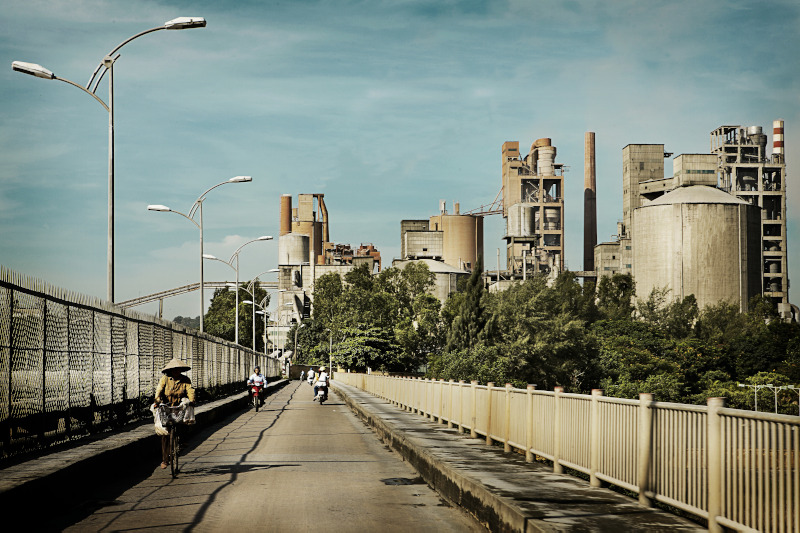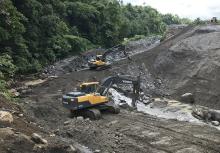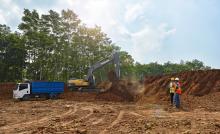
The Philippines, Vietnam and Thailand have enjoyed recent economic growth and their construction materials markets are being driven by high levels of government investment in infrastructure.
Commenting on collective market conditions across the three countries, Ben Weetman VP, minerals, Asia-Pacific at Metso said: “Because of the close geographical proximity [of Thailand, the Philippines and Vietnam], the market is quite price sensitive as there is significant competitive pressure from both Western, Chinese and Indian OEMs [original equipment manufacturers] as they also see significant potential in this geographical region.”
The Philippines construction industry registered a growth of 15.1% in real terms in 2018, according to a report from GlobalData. This was preceded by an average annual growth of 9.6% during the preceding four years. Growth between 2014 and 2018 was driven by positive developments in regional economic conditions and government investment in residential, transport and energy infrastructure.
There were 61 major quarrying sites operating in the Philippines in 2018, according to the country’s Department of Environment and Natural Resources. These comprised 35 limestone/shale quarries, five silica quarries, 15 aggregate quarries, one dolomite quarry, three clay quarries, two sand & gravel quarries. There were also 3,389 small quarries and sand & gravel operations that were covered by permits issued by LGUs (local government units).
A M Muralidharan, VP sales support and dealer development for Volvo Construction in APAC (Asia-Pacific region), says that the company sees most demand in the Philippines for wheeled loaders with capacity between three and six tonnes and excavators with load capacities between 20 and 50 tonnes.
“Typically the wheeled loaders and excavators are used for handling stockpiles and loading materials into trucks,” Muralidharan adds. “In the Philippines, wheeled loaders are typically used in the stockpile area or in a local redistribution centre/sales zone, and each aggregate site usually deploys one to two units to load aggregate trucks. Excavators in the Philippines are mainly used in the quarry area handling blasted raw materials.”
In terms of excavators in the Philippines, Muralidharan says that contractors typically select breaker piping to use in quarries.
Weetman says the Philippines market is characterised by a strong infrastructure-growth agenda which is being driven by government policies on the back of the highest population growth rate in South-East Asia.
“There is also a renewed focus on long-term infrastructure development,” he adds. “The Philippines is driven by the government’s strong focus on infrastructure and nation-building initiatives, thereby creating strong growth in aggregates demand in the Philippines.”
One such example is the ‘San Miguel’ project to build what is claimed to be the world’s second largest airport. The US$15bn, four runway airport is to be built 30km north of Manila and will be able to handle up to 100 million passengers a year when completed. The project is being conducted by the brewing, food, energy and infrastructure conglomerate San Miguel.
Such projects are expected to continue the expansion in real terms of Philippines construction industry output value for the period through to 2023. The GlobalData report states that, in addition, public and private sector investments in residential, commercial and educational infrastructure construction projects are expected to support growth in the industry over the next three years.
“The government’s investment in the development of the country’s transport infrastructure under the ‘Build, Build, Build’ programme is expected to support industry growth,” the report adds.
In the 2019 budget, the government proposed to spend PHP909.7bn (US$17.2bn) under the ‘Build, Build, Build’ programme to develop the country’s crumbling transport infrastructure. In addition, the government’s aim to improve local energy resources is expected to support investment in energy infrastructure projects, which will in turn fuel growth in the industry.
The industry’s output value in real terms is expected to rise at a compound annual growth rate (CAGR) of 8.6% through to 2023.GlobalData expects the Philippines’ residential construction market to retain its leading position and account for 34.7% of the industry’s total value in 2023, driven by ongoing urbanisation, population growth and positive developments in regional economic conditions. The government’s efforts to build affordable housing units for the country’s low- and middle-income population in order to address the country’s housing shortage are also expected to support the market.
The total construction project pipeline in the Philippines – as tracked by GlobalData, and including all megaprojects with a value above US$25m – stands at PHP19.1 trillion (US$361.6bn). The pipeline, which includes all projects from pre-planning to execution, is skewed towards early-stage projects, with 55.0% of the pipeline value being in projects in the pre-planning and planning stages as of April 2019.

Volvo CE equipment is being used in a preservation project to protect Filipino villagers’ homes from erupting volcanoes. The project is also designed to keep local economies thriving by ensuring that valuable aggregates found within those lava streams are contained safely. The Mayon volcano near the city of Legazpi is one of the most active volcanoes in the Philippines. While volcanic soil is extremely fertile for farming, lava flows are always a hazard. In addition, the wet season from July to December also poses challenges with the high volume of rainwater and debris it brings from the volcano.
To alleviate this, the local government financed construction of a network of spillways around the volcano, to direct the flow of rain, debris and lava. As a result, four Volvo CE EC210D units helped enable protection to villagers living near the Mayon volcano by directing volcanic materials away from populated areas and into designated and contained areas. The heavy-duty machines have just finished building the spillways for this particular project with Sunwest Construction and Development Corporation, but Volvo machines are still at work around Mount Mayon with another contractor.
“The fear of an eruption is always present among the villagers and they are really grateful that these spillways are being constructed,” says Joel Banzuela, project foreman at regional contracting company Sunwest Construction and Development.

The Thailand quarrying and aggregates market is currently enjoying strong economic development, according to Amarit Maneesaovanop, general manager – aggregates, Bangkok Siam City Concrete Company. He added that its national consumption of aggregates is estimated at about 203.2 million tonnes per year. The national geology is very varied, and, correspondingly, so is the type of aggregates produced in each region. The estimated overall breakdown is around 60% crushed rock and 40% sand & gravel.
“Aggregates are typically transported 150-200km to market, in almost all cases by truck; the main markets are in the Greater Bangkok and Eastern Seaboard areas,” Maneesaovanop stated. “There is a small amount of rock export, but no imports.”
He added that there is growing investment in new quarries.
Thailand is mature in the aggregates industry, according to Metso’s Weetman. “There is a strong history of aggregates production supporting the local and Indochina area with high usage of Western OEM equipment,” he adds. “There’s a positive sentiment and a need for new and upgrading of existing infrastructure in Thailand with large projects like the high-speed rail linking Malaysia and Singapore. There is renewed optimism in the aggregate industry.”
Aggregates consumption in Thailand for 2019 was estimated at over 350 million tonnes per annum in a GlobalData report.
Muralidharan of Volvo CE said that demand for excavator-class-size in Thailand depends on the aggregate type and quarry size. “Thailand quarries are 80% limestones and 20% granite, and 70% of quarries in Thailand produce less than 300 tonnes per hour,” he added. “This is why sometimes excavators over 35-tonnes are above what’s required on the quarry, and one of the reasons why 20-tonne class excavators like the EC200D and EC210D are popular.”
He said that quarry owners in Thailand like the EC200D and EC210D because they offer high return on investment while delivering fast cycle times and high productivity.
“Over the next five years, the Thai government is pushing spending on new megaprojects as part of the Eastern Economic Corridor, which will see investments in major facilities like high-speed trains, deep-sea ports and new airports,” Muralidharan says. He expects to see higher demand for aggregates in Thailand thanks to infrastructure investments.
Beyond 2025, Muralidharan says it is unclear how high demand for aggregates will be, but he adds there could be demand for aggregates from Thailand’s connection to China’s ‘One Belt, One Road’ project, which is also investing in industrial buildings and transport connections. Thailand’s construction industry regained growth momentum in 2018, according to GlobalData. Output expanded by 2.7% in real terms – up from -2.8% in 2017.
The industry is expected to continue to expand in the period up to 2023, but at a slower pace than in recent years. Growth will be driven by the government’s efforts to develop the country’s transport infrastructure, coupled with efforts to boost the residential construction market. In the first half of 2019, the government announced plans to allocate THB4bn (US$125.6m) to finance five low-cost housing projects in the country, while in the 2020 budget, the government allocated THB650bn (US$20.4bn) towards capital expenditures. The focus on the development of the energy sector is also expected to drive industry growth.
Investments to develop infrastructure in Chachoengsao, Chonburi and Rayong provinces under the Eastern Economic Corridor (EEC) scheme are also expected to support growth in the industry over the next three years. In order to attract foreign manufacturing companies, create a value-based economy and reduce social disparity, the government is developing the EEC, a new industrial zone. In October 2018, the government agreed to approve four more large-scale infrastructure projects under the EEC scheme.
GlobalData predicts the residential construction market will account for 40.3% of the industry’s total value in 2023, supported by ongoing urbanisation and government efforts to balance housing demand and supply through the construction of low-cost housing units.
To transform Thailand into a gateway to South Asia and develop a link to the Eastern Economic Corridor, in January 2019 the government approved THB106.8bn (US$3.4bn) to develop the Southern Economic Corridor (SEC) over the next four years. The plan seeks to develop 116 projects in Chumphon, Surat Thani, Nakhon Si Thammarat and Ranong provinces during the period of 2019-2022.Infrastructure construction market growth over the forecast period will be driven by public and private sector investments in the development and modernisation of the country’s transport infrastructure. In the first half of 2019, the State Railway of Thailand (SRT) announced plans to invest THB90bn (US$3m) to develop and upgrade railway tracks in the country’s southern region, in a bid to reduce travel time and encourage tourism in the region.
In January 2019, the National Energy Policy Council approved the updated Power Development Plan (PDP 2018-2037). Under this plan, the country’s power production capacity is expected to increase by 67.5%, going from 46,090MW in 2017 to 77,211MW in 2037.
The total construction project pipeline in Thailand – as tracked by GlobalData, and including all megaprojects with a value above US$25m – stands at THB11.5 trillion (US$355.9bn). The pipeline, which includes all projects from pre-planning to execution, is skewed towards late-stage projects, with 60.3% of the pipeline value being in projects in the pre-execution and execution stages as of October 2019.
Promoting industrialisation and modernisation are among the major goals of the Vietnamese Central Government and this is accompanied by fast urban growth, according to an academic study published in August 2019 by MDPI. The proportion of urban population is expected to grow from 38% in 2015 to 45% by the end of this year and 50% by 2025, according to government estimates. The academic study states that the main driving forces behind this fast urbanisation are public investment in infrastructure and the opening up of land to leaseholds entitlement. “These driving forces put housing and infrastructure development in all urban areas under enormous pressure, causing an unprecedented demand for aggregates in the construction sector,” the study’s authors add.
Driven by foreign investments Vietnam is emerging as a key player in the South-East Asia regional economy, according to Weetman.
“As Vietnam grows and develops, there is a high level of trajectory of infrastructure spend,” he adds. “Because of this, [Vietnam] is looking for more efficient and effective ways in productivity through innovative products, high level of technology and automation as it develops. As the economy opens up for further foreign direct investment, coupled with the government opening up to western investment and fuelled by strong population growth, Vietnam has shown an increase in demand for infrastructure and aggregate products to sustain [this].”
Vietnam’s construction industry registered growth of 8.5% in real terms in 2018, according to GlobalData. This follows an average annual growth rate of 9.3% during the preceding four years, when growth was driven by positive developments in regional economic conditions and government investment in energy and transport infrastructure.
The industry’s output value is expected to continue to expand in real terms over the forecast period (2019-2023), with investments in infrastructure construction, tourism infrastructure and housing projects continuing to drive growth. According to government estimates, the country requires an investment of VND1.0 quadrillion (US$48bn) until 2023 to develop its transport infrastructure. In addition, the government’s aim to improve local energy resources is expected to support investment in energy infrastructure projects, which will in turn fuel growth in the industry.
The trade war between the US and China is also expected to divert foreign investment towards Vietnam, given the relative improvement in the country’s attractiveness as a manufacturing destination. GlobalData predicts this is likely to have a positive impact on the construction industry, particularly in the industrial and logistics sectors.
The industry’s output value in real terms is expected to rise at a compound annual growth rate of 7.87% between 2019 and 2023.
GlobalData expects the residential construction market to account for 42.6% of the industry’s total value in 2023 driven by the country’s rising population, ongoing urbanisation and positive developments in regional economic conditions. Market expansion through to 2023 is also expected to be driven by public and private sector investments in the construction of new residential buildings to meet the increasing demand for housing.
Forecast-period growth in the energy and utilities construction market will be driven by the government’s plan to increase the share of renewable energy in terms of the total energy mix, encouraging investment in renewable energy infrastructure. The government aims to generate 31% of the country’s total consumer primary energy through renewable sources by 2020, 32.3% by 2030 and 44% by 2050. The plan is to generate 3.3% of the country’s total electricity production through solar power by 2030 and 20% by 2050.

The Vietnam National Cement Corporation (VICEM) and cement equipment company FLSmidth have started a cooperation to develop new solutions to improve the sustainability of Vietnam’s cement sector. The Vietnamese government has set objectives to reduce the environmental impact of cement production.
The two companies say the goal is to implement technologies that radically reduce greenhouse gas emissions, pioneer solutions for using alternative fuels and improve air quality.
Vietnam is a fast-growing country in terms of cement production with output expected to double in the next ten years, and it is also a big exporter of cement. The Vietnamese government has set objectives to improve efficiency and reduce the environmental impact of its cement production.
Cement producer VICEM says its ambition is to take an industry-leadership role and implement solutions to reduce the environmental impact of cement production. This will specifically focus on reducing the emission of particulate matter, CO2, NOX and SO2 to prevent air, soil and water pollution from waste burning and landfills.
The total construction project pipeline in Vietnam – as tracked by GlobalData in January 2019, and including all megaprojects with a value above US$25m – stood at VND13.4 quadrillion (US$588.6bn).
Looking at general demand for quarrying and aggregates equipment across the Philippines, Thailand and Vietnam, Weetman says that large fixed plants are looking at economies of scale, high productivity and high efficiency.
Smaller operators/contract quarries/construction contractors are looking to grow mobile (tracked and wheeled) solutions. “More efficient asset utilisation is key for them,” Weetman adds. “In addition, productivity and efficiency plays a role, as well as reducing reliance on quarry haulage investment.”










